

Cities are getting smarter. From the many small municipalities that have recently installed smart meters to measure electric power consumption, to the handful of large megalopolis’ that have adopted a far-reaching and broad array of systems and technologies for all key functions, the world of smart cities is a huge challenge to navigate and 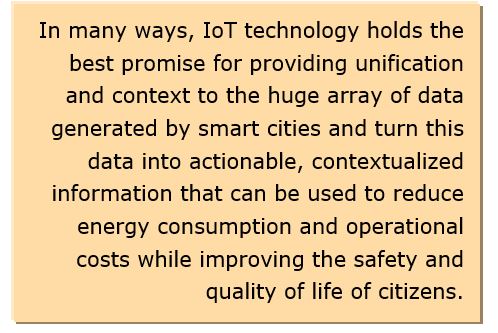
Smart cities are comprised of a “system of systems.” These can include smart lighting systems, building automation systems, emergency management systems, security and access control systems, intelligent grids, renewable power, water treatment and supply, transportation, and more. The smart city concept is not new; many of these systems existed well before the term “smart cities” was coined. However, many end users are now attempting to tie together information from these disparate systems into a unified whole to provide a holistic view of the overall performance and state of the city and its various functions.
The age of the Internet of Things has brought with it an increasingly broad range of sensors and IoT platforms. Many of these have made their way into the smart cities sector. In many ways, IoT technology holds the best promise for providing unification and context to the huge array of data generated by smart cities and turn this data into actionable, contextualized information that can be used to reduce energy consumption and operational costs while improving the safety and quality of life of citizens.
This report provides a brief overview of ARC Advisory Group’s perspective on smart cities and the various systems, platforms, sensors, computing devices, and network infrastructure required. We’ve highlighted smart grid and smart lighting systems to show some of the key challenges and headwinds that end users face when adopting smart city technologies. Unfortunately, cybersecurity is often overlooked in smart city discussions, so we will examine some key considerations here. Just as in the industrial world, end users in the smart cities sector must evaluate technologies based on their ability to provide business value and their impact on health, safety, and environment.
While the concept of a smart city is not new, it is still evolving and goes by many different definitions. Clearly, many 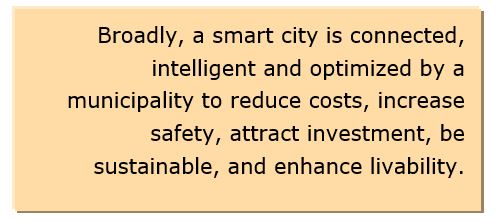
ARC has identified 12 key smart city application sectors: transportation, utilities, environment, public safety & security, governance, buildings, education, health, retail & logistics, manufacturing & construction, finance & banking, and amenities. Among these, ARC market research and strategic planning and analysis capabilities cover:
Each can be viewed as either a standalone system or as part of a larger, holistic smart city system. As pointed out previously, many of these systems were installed and have existed well before the era of smart cities but, today, incorporate a new range of smart sensors and IoT-enabling technologies that change the way these systems look and work. Many end users today strive for a single common system that can be applied to a wide range of application areas. This is where smart city platforms come in.
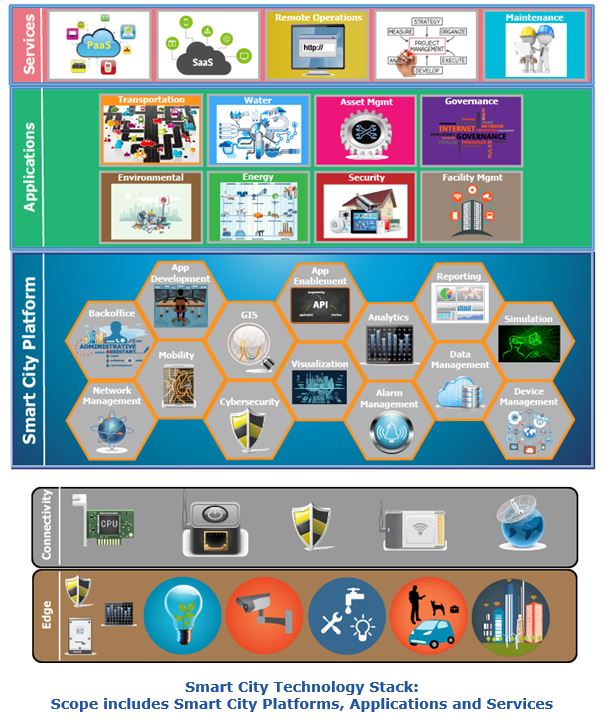
In the Industrial Internet of Things architecture, smart city platforms reside at the enterprise level. These platforms perform many functions, including: analytics, remote asset monitoring, performance management, decision support and/or presentation components.
At a minimum, the functionality of a smart city platform must include:
The platform may also include:
Smart city platforms may be deployed in a private, public, or hybrid cloud, via remote server, or on-premise. Private clouds are maintained by the platform provider. Amazon Web Services (AWS) is rapidly emerging as the most popular public cloud in this space. Hybrid public/private clouds are also a popular option, with the public cloud in place to serve peaks in data demand.
City managers around the world are launching smart city initiatives to improve the efficiency, effectiveness, and attractiveness of their infrastructure and services. New technology developments are central to these efforts, but require appropriate selection and implementation. Having a proper technology strategy in place before launching a major program is essential to avoid a massive proliferation of incompatible solutions that constrain benefits and escalate ongoing support costs.
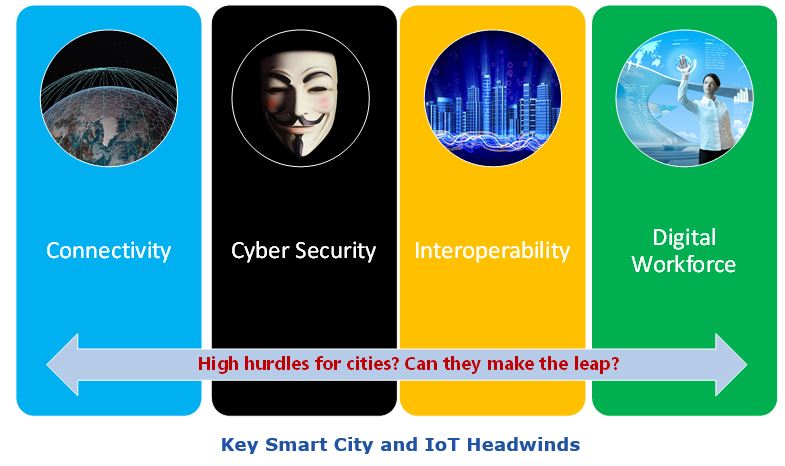
Managers of large metropolitan areas face almost overwhelming challenges. Operations and maintenance costs for city services, buildings, and light systems are escalating. Aging infrastructure is undermining the reliability of critical infrastructure like water, gas, electricity, and sewage. Population growth is straining the adequacy of roads, parking, public transportation, education, medical, and public safety services. Improvements in communications, environment, and city amenities are needed to sustain and expand regional business investments. Declining tax revenues further complicate this situation. City planners need to act quickly to avoid further erosion, but they also need to maximize the benefits of every investment.
City managers need affordable solutions to address these challenges and they need to anticipate future needs. As these needs are hard to predict, solutions must be flexible and scalable, enabling future additions, modifications, and improvements. A well-defined investment roadmap is also critical to maximize opportunities for leveraging self-funding rollouts.
Working with governing bodies is complex, with extreme geographical nuances. But the government market also offers tremendous potential due to its enormous purchasing power. The approaches and the purchasing process will vary widely from a region, country, and city perspective. These processes are often restricted by policies in place that were created before smart city technologies existed and the benefits not yet known.
The structure and level of the political bodies involved and the rights and needs of its citizens can significantly impact the leaders’ ability to plan, direct, fund, and implement the technologies successfully. For example, Singapore, whose citizens tend to be tech savvy and largely unfazed by government intrusion, can push technology boundaries and set an example for other cities worldwide. It provides a showcase for how digital transformation can improve citizens’ lives with its ability to implement technologies rapidly and apply these to deliver new innovative services with clear benefits.
In Europe and Asia, we observe more structured approaches and plans being laid out at a regional and country level, respectively. This provides an advantage. The EU’s strategic, collaborative approach is producing results. They are moving towards open standards and setting policies to enable the free flow of data between countries.
Financially, working with the government sector is radically different than in the private sector and the process of digital transformation for cities tests the constraints of traditional practices.
In a data-driven society, the sheer volume of data is accelerating on an upward slope. Our reliance on human-machine collaboration to be successful will require the velocity, veracity, security and the universal interoperability of data. The explosion in hardware vendors, the number of communication protocols, and the lack of standardization of metadata and labeling among system integrators, has created an environment in which data brokering between devices may be lost in translation or broken. The desired flow of data back and forth between databases, levels of the technology stack, applications, industries, regions, countries and freely throughout the global economy does not yet exist. The vision of machines flowing seamlessly around us and enhancing our lives sounds wonderful, but this utopia will remain a fantasy if communication barriers remain and the data the sensors are collecting cannot be used to provide contextual awareness.
Vendors have always preferred proprietary and closed systems since these tend to garner premium prices and lock a customer into a specific vendor. Cities should take advantage of the potential power they now have to collaborate to accelerate and institute radical changes to the market. The EU has been working strategically with FIWARE and the Open and Agile Smart Cities (OASC) group to standardize on the same open source platform. This standardization effort has spread to Brazil, Mexico, and most recently to Japan with its new partner, NEC. The EU is working on setting a single standard for data brokering between countries, as the ability to pool data into data oceans over data lakes will (in theory) generate deeper and more accurate analytical insights.
This is something that needs to be dealt with here in the US at the federal, state, and city levels and solved globally as economies and currency become ever-more digitized. Who owns and has access to the data? Technology outpaces policy, often making municipalities hesitant to invest early. For example, spending a few million dollars to deploy security cameras that the citizens or their representatives deem to be an invasion of privacy is clearly not worth the risk.
Data brokering is important, but probably represents less than half the battle. Semantic interoperability and contextual awareness of the data is an even greater problem, which will only be solvable when machines and systems become more self-aware. To illustrate this point, consider that if a system integrator in New York labels a camera “centralpark.west.camera,” and another integrator labels a camera at the Boston Common, “8383919,” the application would not be portable and require significant custom engineering to provide much value. While some SI organizations at least use their own naming conventions, others have no organizational standards at all. Project Haystack, supported by Siemens, is trying to tackle this at the building level, but the issue exists across industry as well and may require applying AI to solve. The number of legacy systems and devices in use worldwide is massive and those who know how these systems work and are designed are retiring en masse.
“Brain drain” remains a top-level concern for asset-intensive industries such as manufacturing, oil & gas, and utilities. Many technically skilled workers are aging out of the workforce, taking invaluable experience and expertise with them into retirement. Companies within these industries are struggling to replace these retiring workers.
At the same time, these industries face an unprecedented and complex mix of operational and market challenges. Companies are juggling infrastructure improvement needs, changing customer expectations, margin pressure, legacy technology obsolescence, and tighter environmental and safety mandates. They believe they can successfully manage these complex market challenges, in part, by digitizing operational processes and customer interactions, ultimately transforming their business and economic models.
These challenges would appear to offer exciting professional opportunities for young, technologically-savvy workers. However, companies (and municipalities) are finding it very difficult to recruit younger workers or transition them from other industries. Electric utility executives are clearly concerned. The results mirror the concerns in other asset-heavy industries and clearly also reach in to the smart cities space.
How can organizations deal with the attrition of experienced workers and the massive skill gaps they create? How can they make new, less experienced workers more effective as aging ones retire? ARC Advisory Group believes that as organizations digitize and leverage the Industrial Internet of Things (IIoT), they can tap machine learning, cognitive analytics and smart, connected devices to help solve those challenges.
ARC recommends that organizations across industry, infrastructure, and municipalities that now face the dual problems of tribal knowledge and knowledge drain consider machine learning, cognitive analytics, and connected devices as possible solutions for mitigating aging workforce issues. To do so, organizations should consider the following actions:
Challenges continue to grow for the industrial cybersecurity community. Lack of resources is undermining the effectiveness of established defenses in many industrial installations, and the same can be said for smart cities. Deployment of IIoT strategies is proceeding without real solutions for critical issues like secure-by-design-devices and 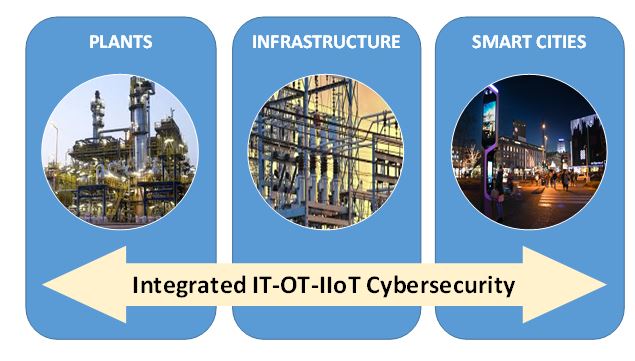
Boundaries between IT, OT and IoT are blurring and increasing the need for integrated cybersecurity strategies. Segregating cybersecurity efforts by technology is no longer a sustainable approach. Organizations need to develop new integrated strategies that combine IT, OT, and IoT security efforts and maximize use of all corporate cybersecurity resources.
Protecting the operational technology (OT) assets in smart city and infrastructure systems are rapidly expanding the need for industrial cybersecurity expertise and practices. Compromises to these systems can jeopardize business continuity, citizen safety, and effective delivery of critical government services like water, sewage, street lighting, traffic signaling, and first responder communications. To avoid such incidents, IT groups and smart city planners need the support of people who understand operational technology and the associated security challenges. Many gaps remain in cybersecurity for smart cities. City governments have expertise in managing some infrastructure, but generally lack the expertise needed to design and maintain the underlying assets. Most also have very limited expertise in the associated OT and IT systems.
As the smart city movement gains momentum, we are now witnessing digital transformation in urban environments of unprecedented complexity and scale. For innovative technology suppliers willing to collaborate with each other, this market presents unlimited future opportunities. For city planners and managers, digital transformation presents significant opportunities to reduce costs, improve efficiencies, improve HSE performance, and make their communities more attractive and “livable” for businesses and residents alike. For city dwellers, smart cities offer the promise of improving their overall quality of life.
Many challenges remain. These relate to bureaucracy, cybersecurity, connectivity, interoperability, and the shortage of municipal workers with the necessary technological expertise. In the smart cities space, it’s likely that global market conditions are likely remain challenging for the next 20 years. This means that many of the benefits that would result from digital transformation expanding and converging beyond the plant, the supply chain and the enterprise; and into the smart city space will remain elusive, for now at least.
However, as the cost of increasing computing power and bandwidth and new microprocessor electronics and sensors all continue to drop, it will become more practical for municipalities to deploy massive wide-area networks of intelligent devices. Smart cities present tremendous opportunities for industrial IoT vendors, but the technical challenges, vast number of players in this ecosystem, and the fact that it bridges private, public, and consumer realms makes navigating and succeeding in this market a challenge.
Cybersecurity, connectivity and working with municipal bureaucracy remain the biggest challenges, but other obstacles include exponential data volume growth, data cleansing speed, the need to go from cloud to edge architectures, quantifying results, interoperability, and human fears/resistance to transformational change such as AI.
Based on ARC research and analysis, we recommend the following actions for civic leaders embarking on a smart cities journey:
All managers want both smart and cybersecure cities, and many are frustrated with their inability to justify investments and take control of efforts that seem to be like “chasing their tails.” They don’t want to become cyber-security experts, but need to be sure that the organization has an appropriate plan for managing cyber threats. This includes being sure that efforts focus on real and relevant (to the company) cyber threats and consider everything needed to keep the associated risks at acceptable levels. They also want a clear way to understand and evaluate additional investments that may be required to address new threats.
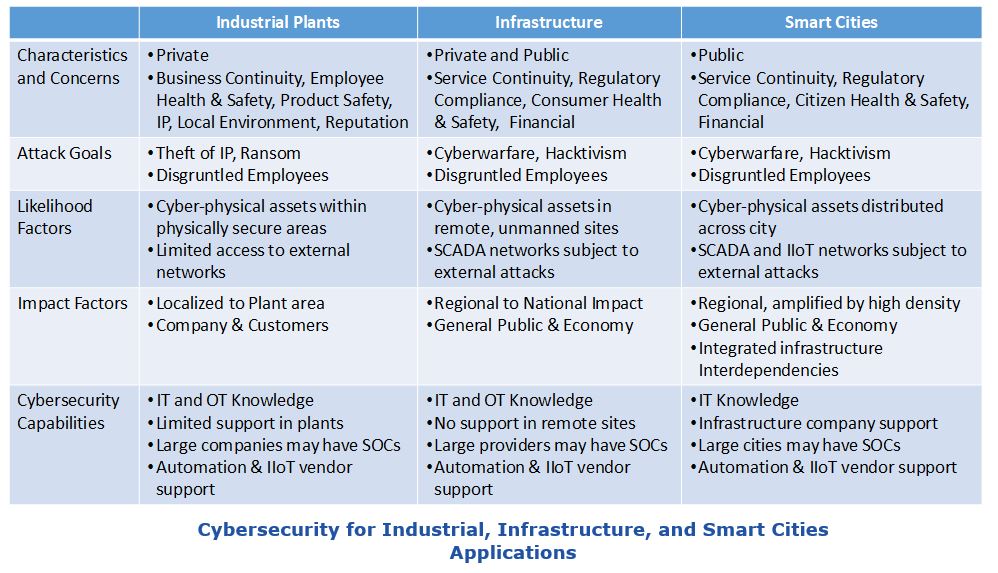
ARC’s cybersecurity maturity model reflects a layered approach to implementing an effective, defense-in-depth cybersecurity strategy. Security is developed outwardly from defense of individual assets to perimeter protection of facilities and monitoring of the external threat landscape. Focus also shifts from protecting devices and building a security culture to managing sophisticated technology and anticipating attacks.
These steps encourage companies to do the obvious and easy things first. This minimizes initial investments and resource requirements and enables every industrial company to achieve at least a minimal level of cyber protection. It also allows companies to improve their security posture while they develop the necessary cybersecurity maturity to avoid wasteful investments on technology that they cannot manage or utilize effectively. For more information, please refer to the ARC strategy report for March 2016 titled A Maturity Model for Industrial Cybersecurity Planning.
If you would like to buy this report or obtain information about how to become a client, please Contact Us

